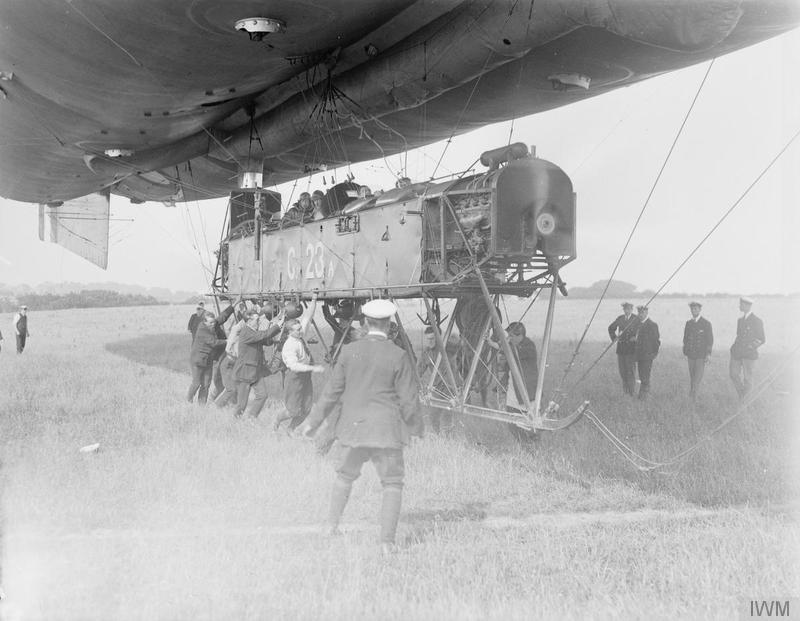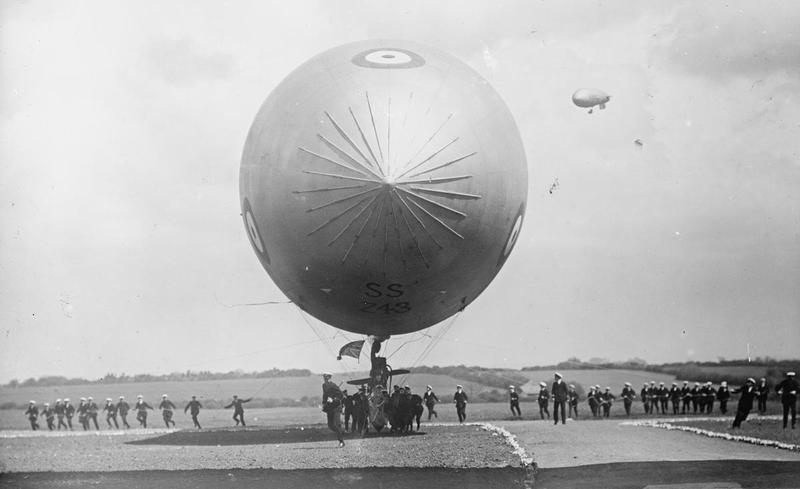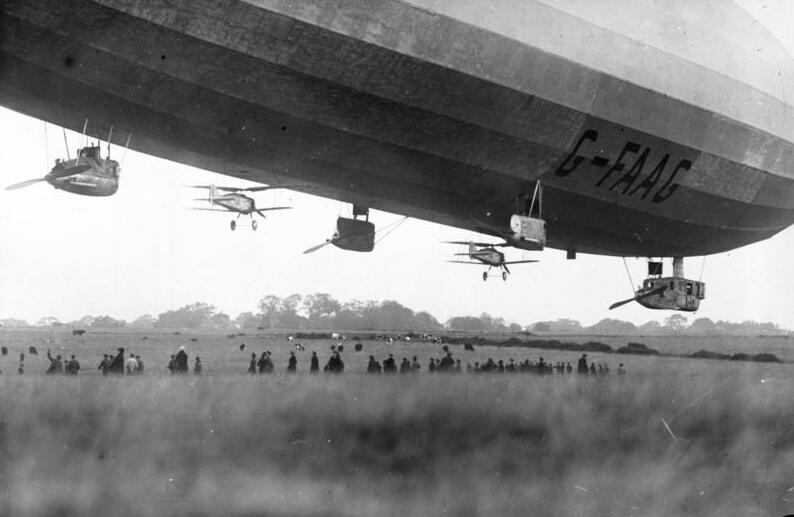|
RNAS Pulham
RNAS Pulham (later RAF Pulham) was a Royal Navy Air Service (RNAS) airship station, near Pulham St Mary south of Norwich, UK. Though land was purchased by the Admiralty in 1912 the site was not operational until 1915. From 1918 to 1958, the unit was a Royal Air Force establishment. The land today is in private ownership, and little remains above ground. However, the Pennoyer Centre in Pulham St Mary holds an extensive archive of photographs and memorabilia relating to the Air Station. History Pulham was one of the main British airship stations, with more than 3,000 men on the base at the end of the First World War. Initially it was used for airships that operated patrols over the North Sea (such as the Coastal and SS types) until their areas were taken over by seaplanes. The R34 landed at RNAS Pulham to complete the first two-way flown crossing of the Atlantic in July 1919. After the loss of the R101 in 1930 and the end of British airships the station was moved on to a ... [...More Info...] [...Related Items...] OR: [Wikipedia] [Google] [Baidu] |
Royal Navy
The Royal Navy (RN) is the United Kingdom's naval warfare force. Although warships were used by English and Scottish kings from the early medieval period, the first major maritime engagements were fought in the Hundred Years' War against France. The modern Royal Navy traces its origins to the early 16th century; the oldest of the UK's armed services, it is consequently known as the Senior Service. From the middle decades of the 17th century, and through the 18th century, the Royal Navy vied with the Dutch Navy and later with the French Navy for maritime supremacy. From the mid 18th century, it was the world's most powerful navy until the Second World War. The Royal Navy played a key part in establishing and defending the British Empire, and four Imperial fortress colonies and a string of imperial bases and coaling stations secured the Royal Navy's ability to assert naval superiority globally. Owing to this historical prominence, it is common, even among non-Britons, ... [...More Info...] [...Related Items...] OR: [Wikipedia] [Google] [Baidu] |
Pulham St Mary
Pulham Saint Mary is a rural village and civil parish in Norfolk, that lies next to the village of Pulham Market. It is situated approximately northeast of Diss and south of Norwich, covers an area of and a population of 892 at the 2011 census. History The parish church, dedicated to St. Mary the Virgin, which gives the village the St Mary in its name, is believed to date from around 1258. The parish church is of flint construction with parts that date back to the thirteenth century. Older maps and documents name the parish or village "Pulham Saint Mary the Virgin" - the latter two words are in modern times dropped, and Saint is typically abbreviated. The neighbouring parish and village, now called Pulham Market, was historically known as "Pulham Saint Mary Magdalene" after the dedication of its parish church. The earliest recorded spelling is PollehamPulhamis referenced in the Domesday Book of 1086 as a single manor (Pulham St Mary with what is today called Pulham Market) ... [...More Info...] [...Related Items...] OR: [Wikipedia] [Google] [Baidu] |
Royal Navy Air Service
The Royal Naval Air Service (RNAS) was the air arm of the Royal Navy, under the direction of the Admiralty's Air Department, and existed formally from 1 July 1914 to 1 April 1918, when it was merged with the British Army's Royal Flying Corps to form the Royal Air Force (RAF), the world's first independent air force. It was replaced by the Fleet Air Arm, initially consisting of those RAF units that normally operated from ships, but emerging as a separate unit similar to the original RNAS by the time of World War 2. Background In 1908, the British Government recognised the military potential of aircraft. The Prime Minister, H. H. Asquith, approved the formation of an "Advisory Committee for Aeronautics" and an "Aerial Sub-Committee of the Committee of Imperial Defence". Both committees were composed of politicians, army officers and Royal Navy officers. On 21 July 1908 Captain Reginald Bacon, who was a member of the Aerial Navigation sub-committee, submitted to the Firs ... [...More Info...] [...Related Items...] OR: [Wikipedia] [Google] [Baidu] |
Norwich
Norwich () is a cathedral city and district of Norfolk, England, of which it is the county town. Norwich is by the River Wensum, about north-east of London, north of Ipswich and east of Peterborough. As the seat of the See of Norwich, with one of the country's largest medieval cathedrals, it is the largest settlement and has the largest urban area in East Anglia. The population of the Norwich City Council local authority area was estimated to be 144,000 in 2021, which was an increase from 143,135 in 2019. The wider built-up area had a population of 213,166 in 2019. Heritage and status Norwich claims to be the most complete medieval city in the United Kingdom. It includes cobbled streets such as Elm Hill, Timber Hill and Tombland; ancient buildings such as St Andrew's Hall; half-timbered houses such as Dragon Hall, The Guildhall and Strangers' Hall; the Art Nouveau of the 1899 Royal Arcade; many medieval lanes; and the winding River Wensum that flows through the city c ... [...More Info...] [...Related Items...] OR: [Wikipedia] [Google] [Baidu] |
British Admiralty
The Admiralty was a department of the Government of the United Kingdom responsible for the command of the Royal Navy until 1964, historically under its titular head, the Lord High Admiral – one of the Great Officers of State. For much of its history, from the early 18th century until its abolition, the role of the Lord High Admiral was almost invariably put "in commission" and exercised by the Lords Commissioner of the Admiralty, who sat on the governing Board of Admiralty, rather than by a single person. The Admiralty was replaced by the Admiralty Board in 1964, as part of the reforms that created the Ministry of Defence and its Navy Department (later Navy Command). Before the Acts of Union 1707, the Office of the Admiralty and Marine Affairs administered the Royal Navy of the Kingdom of England, which merged with the Royal Scots Navy and the absorbed the responsibilities of the Lord High Admiral of the Kingdom of Scotland with the unification of the Kingdom of Gr ... [...More Info...] [...Related Items...] OR: [Wikipedia] [Google] [Baidu] |
Royal Air Force
The Royal Air Force (RAF) is the United Kingdom's air and space force. It was formed towards the end of the First World War on 1 April 1918, becoming the first independent air force in the world, by regrouping the Royal Flying Corps (RFC) and the Royal Naval Air Service (RNAS). Following the Allied victory over the Central Powers in 1918, the RAF emerged as the largest air force in the world at the time. Since its formation, the RAF has taken a significant role in British military history. In particular, it played a large part in the Second World War where it fought its most famous campaign, the Battle of Britain. The RAF's mission is to support the objectives of the British Ministry of Defence (MOD), which are to "provide the capabilities needed to ensure the security and defence of the United Kingdom and overseas territories, including against terrorism; to support the Government's foreign policy objectives particularly in promoting international peace and security". ... [...More Info...] [...Related Items...] OR: [Wikipedia] [Google] [Baidu] |
Coastal Class Blimp
__NOTOC__ The Coastal Class (often known as the C-Class or simply the 'Coastals') were a class of non-rigid airship or "blimp" used by the Royal Naval Air Service (RNAS) during World War I. The C-class blimp operated by the United States Navy after the war was a completely unrelated design. In total 35 Coastals were built, all at RNAS Kingsnorth, Kent. Entering service in 1916, the Coastal class remained in widespread service until 1918, with a few members of the class still in service at the signing of the Armistice, while others were replaced by the improved C-Star class as they became unfit for service. The blimps were used for long anti-submarine patrols in the Western Approaches and English Channel, protecting convoys from German U-boats. The Coastal class was one of the first aircraft types specifically designed to detect and attack submarines. History and design The C-Class was far from a new design. The prototype was built in 1915 by using the envelope from the No. 10 ... [...More Info...] [...Related Items...] OR: [Wikipedia] [Google] [Baidu] |
SS Class Blimp
SS (''Submarine Scout'' or ''Sea Scout'') class airships were simple, cheap and easily assembled small non-rigid airships or "blimps" that were developed as a matter of some urgency to counter the German U-boat threat to British shipping during World War I. A secondary purpose was to detect and destroy mines. The class proved to be versatile and effective, with a total of 158 being built in several versions.SS class airship. Airship Heritage Trust. Retrieved on 18 March 2009. Requirement Soon after the outbreak of World War I, the threat to British shipping from German submarines became increasingly apparent, with numerous losses occurring during October and November 1914. Then, on 4 February 1915, a communiqué issued by the[...More Info...] [...Related Items...] OR: [Wikipedia] [Google] [Baidu] |
R33 Class Airship
The R.33 class of British rigid airships were built for the Royal Naval Air Service during the First World War, but were not completed until after the end of hostilities, by which time the RNAS had become part of the Royal Air Force. The lead ship, R.33, served successfully for ten years and survived one of the most alarming and heroic incidents in airship history when she was torn from her mooring mast in a gale. She was called a "Pulham Pig" by the locals, as the blimps based there had been, and is immortalised in the village sign for Pulham St Mary. The only other airship in the class, R.34, became the first aircraft to make an east to west transatlantic flight in July 1919 and, with the return flight, made the first two-way crossing. It was decommissioned two years later, after being damaged during a storm. The crew nicknamed her "Tiny". Design and development Substantially larger than the preceding R31 class, the R.33 class was in the design stage in 1916 when the Ger ... [...More Info...] [...Related Items...] OR: [Wikipedia] [Google] [Baidu] |
R101
R101 was one of a pair of British rigid airships completed in 1929 as part of a British government programme to develop civil airships capable of service on long-distance routes within the British Empire. It was designed and built by an Air Ministry–appointed team and was effectively in competition with the government-funded but privately designed and built R100. When built, it was the world's largest flying craft at in length, and it was not surpassed by another hydrogen-filled rigid airship until the LZ 129 ''Hindenburg'' was launched seven years later. After trial flights and subsequent modifications to increase lifting capacity, which included lengthening the ship by to add another gasbag,"R101". Airship Heritage Trust via Airshipsonline.com. Retrieved: 23 July 2008. the R101 crashed in France during its maiden overseas voy ... [...More Info...] [...Related Items...] OR: [Wikipedia] [Google] [Baidu] |
Hydrogen
Hydrogen is the chemical element with the symbol H and atomic number 1. Hydrogen is the lightest element. At standard conditions hydrogen is a gas of diatomic molecules having the formula . It is colorless, odorless, tasteless, non-toxic, and highly combustible. Hydrogen is the most abundant chemical substance in the universe, constituting roughly 75% of all normal matter.However, most of the universe's mass is not in the form of baryons or chemical elements. See dark matter and dark energy. Stars such as the Sun are mainly composed of hydrogen in the plasma state. Most of the hydrogen on Earth exists in molecular forms such as water and organic compounds. For the most common isotope of hydrogen (symbol 1H) each atom has one proton, one electron, and no neutrons. In the early universe, the formation of protons, the nuclei of hydrogen, occurred during the first second after the Big Bang. The emergence of neutral hydrogen atoms throughout the universe occur ... [...More Info...] [...Related Items...] OR: [Wikipedia] [Google] [Baidu] |
.jpg)







